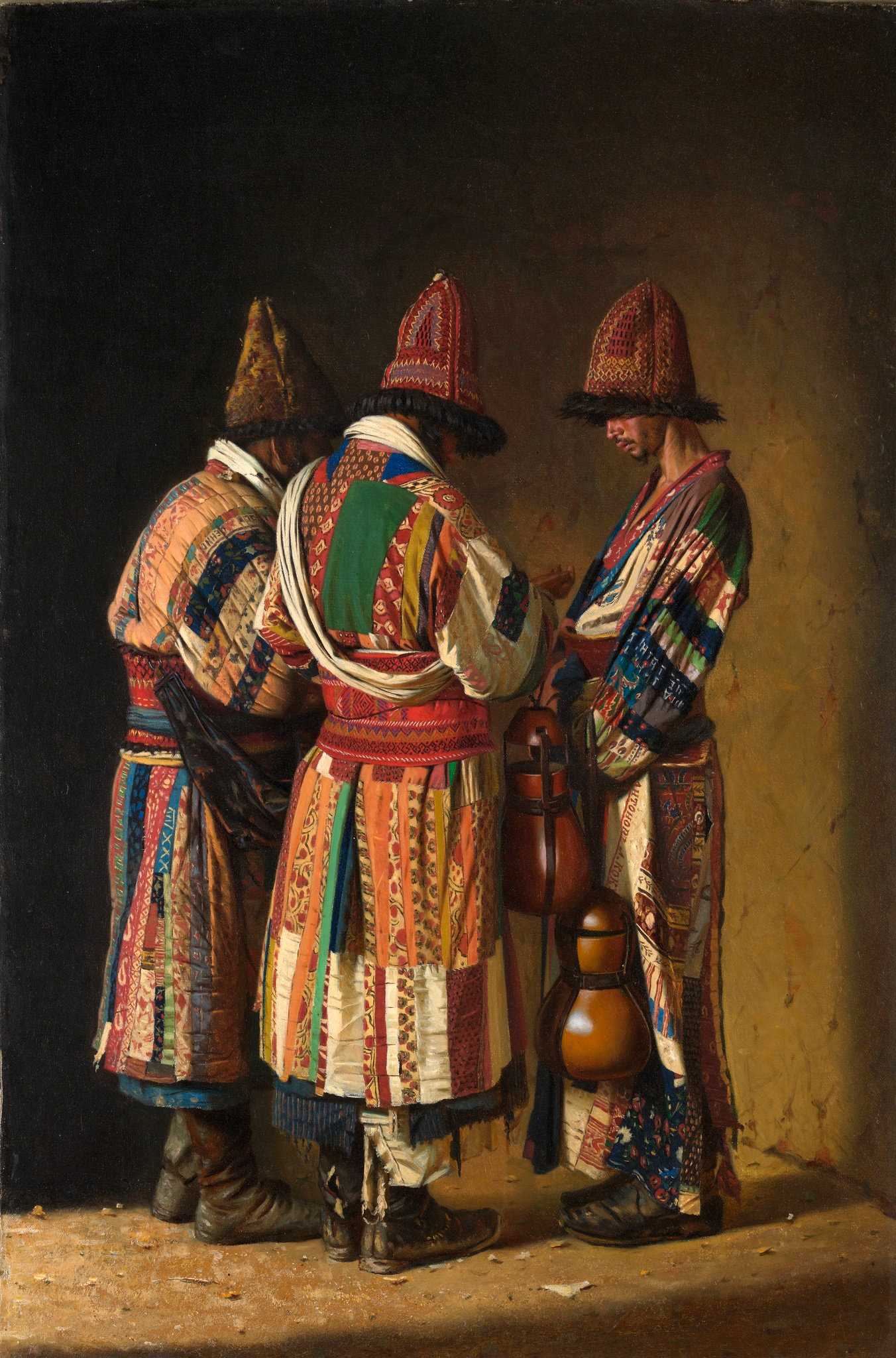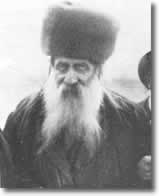|
Kalpak
Calpack, kalpak, or qalpaq ( kaa, калпак, tr, kalpak ; kk, қалпақ, ky, калпак, both ; bg, калпак; el, καλπάκι ('); pl, kołpak; uk, ковпак, ') is a high-crowned cap (usually made of felt or sheepskin) worn by Circassians, Dagestanis, Chechens, men in Turkey, Ukraine, the Balkans and throughout Central Asia and the Caucasus. The kalpak is used to keep the head warm in winter and shade out the sun during summer. There are different kalpaks for different seasons, with kalpaks used in winter being thicker and the ones used in summer being thinner but broader for shading purposes. There are many styles of kalpak. They usually can be folded flat for keeping or carrying when not being worn. The brim can be turned up all the way around. Sometimes there is a cut in the brim so that a two-pointed peak can be formed. Plain white ones are often reserved for festivals and special occasions. Those intended for everyday use may have a black velvet ... [...More Info...] [...Related Items...] OR: [Wikipedia] [Google] [Baidu] |
Karakalpaks
The Karakalpaks or Qaraqalpaqs (; kaa, Qaraqalpaqlar, Қарақалпақлар, قاراقلپقلر), are a Turkic ethnic group native to Karakalpakstan in Northwestern Uzbekistan. During the 18th century, they settled in the lower reaches of the Amu Darya and in the (former) delta of Amu Darya on the southern shore of the Aral Sea. The name "Karakalpak" comes from two words: ''qara'' meaning "black" and '' qalpaq'' meaning "hat". The Karakalpaks number nearly 620,000 worldwide, out of which about 500,000 live in the Uzbek Republic of Karakalpakstan. Etymology The word Karakalpak is derived from the Russian Cyrillic spelling of their name and has become the accepted name for these people in the West. The Karakalpaks endonymically refer to themselves as ''Qaraqalpaqs'', whilst the Uzbeks call them ''Qoraqalpoqs''. The word means "black hat" and has caused much confusion in the past, since historians linked them with other earlier peoples (such as Cherniye Klobuki), who h ... [...More Info...] [...Related Items...] OR: [Wikipedia] [Google] [Baidu] |
Karakalpak Language
Karakalpak is a Turkic language spoken by Karakalpaks in Karakalpakstan. It is divided into two dialects, Northeastern Karakalpak and Southeastern Karakalpak. It developed alongside Uzbek and neighboring Kazakh languages, being markedly influenced by both. Typologically, Karakalpak belongs to the Kipchak branch of the Turkic languages, thus being closely related to and highly mutually intelligible with Kazakh. Classification Karakalpak is a member of the Kipchak branch of Turkic languages, which includes Kazakh, Bashkir, Tatar, Kumyk, Karachay, Nogai and Kyrgyz. Due to its proximity to Uzbek, much of Karakalpak's vocabulary and grammar has been influenced by Uzbek. Like the vast majority of Turkic languages, Karakalpak has vowel harmony, is agglutinative and has no grammatical gender. Word order is usually subject–object–verb. Geographic distribution Karakalpak is spoken mainly in the Karakalpakstan Autonomous Republic of Uzbekistan. Approximately 2,000 people in Afg ... [...More Info...] [...Related Items...] OR: [Wikipedia] [Google] [Baidu] |
Bashlyk
A bashlyk, also spelled bashlik ( krc, Başlıq, Adyghe: ''Shkharkhon,'' Abkhaz: ''qtarpá'', Chechen: ''Ċukkuiy,'' Ossetic: ''Kaskæ'' crh, Başlıq, Tatar: Başlıq, Turkish: Başlık; "baş" - head, "-lıq" (''Tatar'') / "-lık" (''Turkish'') - derivative suffix)'','' is a traditional Turkic, Caucasian, Iranian, and Cossack cone-shaped headdress hood, usually of leather, felt or wool, an ancient round topped felt bonnet with lappets for wrapping around the neck. Local versions determine the trim, which may consist of decorative cords, embroidery, jewelry, metallized strings, fur balls or tassels. Among dozens of versions are winter bashlyks worn atop regular headdress, cotton bashlyks, homeknitted bashlyks, silk bashlyks, scarf bashlyks, down bashlyks, dress bashlyks, jumpsuit-type bashlyks, etc. Bashlyks are used as traditional folk garment, and as uniform headdress. A variation of bashlyks is a Kalpak (Qalpaq), a cone-shaped headdress without lappets, mostly made of ... [...More Info...] [...Related Items...] OR: [Wikipedia] [Google] [Baidu] |
Kurhars
This table of types of hijab describes terminologically distinguished styles of Islamic clothing commonly associated with the word ''hijab''. The Arabic word ''hijДЃb'' can be translated as "cover, wrap, curtain, veil, screen, partition", among other meanings. In the Quran it refers to notions of separation, protection and covering in both literal and metaphorical senses. Subsequently, the word has evolved in meaning and now usually denotes a Muslim woman's veil In English, the term refers predominantly to the Islamic head covering for women and its underlying religious precepts. at Oxford Dictionaries See also * |
Central Asia
Central Asia, also known as Middle Asia, is a subregion, region of Asia that stretches from the Caspian Sea in the west to western China and Mongolia in the east, and from Afghanistan and Iran in the south to Russia in the north. It includes the former Soviet Union, Soviet republics of the Soviet Union, republics of Kazakhstan, Kyrgyzstan, Tajikistan, Turkmenistan, and Uzbekistan, which are colloquially referred to as the "-stans" as the countries all have names ending with the Persian language, Persian suffix "-stan", meaning "land of". The current geographical location of Central Asia was formerly part of the historic region of Turkestan, Turkistan, also known as Turan. In the pre-Islamic and early Islamic eras ( and earlier) Central Asia was inhabited predominantly by Iranian peoples, populated by Eastern Iranian languages, Eastern Iranian-speaking Bactrians, Sogdians, Khwarezmian language, Chorasmians and the semi-nomadic Scythians and Dahae. After expansion by Turkic peop ... [...More Info...] [...Related Items...] OR: [Wikipedia] [Google] [Baidu] |
List Of Headgear
This is an incomplete list of headgear (anything worn on the head), both modern and historical. Hats File:Akubra-style hat.jpg, Akubra File:98-5-E Helmet, Flight, U.S. Army Air Corps, Type A-II (5123665596).jpg, Leather flight helmet File:Balmoral bonnet black.jpg, Balmoral bonnet, Balmoral File:Baseball cap.jpg, Baseball cap File:Paulgoldschmidt1-head.jpg, Batting helmet File:Beanie 1.jpg, Beanie (seamed cap), Beanie or ''skully'' and or visor beanie. File:Jonathan_Bourne-May_(cropped).jpg, Bearskin cap File:Beaver-felt-hat-ftl.jpg, Beaver hat File:Sven Palmqvist 1965.jpg, Beret File:StrawBoater.jpg, Boater (also basher, skimmer, cady, katie, somer, or sennit hat) File:Hufflepuff Hat.jpg, Bobble hat (tuque) File:Tigerstripehat.JPG, Boonie hat File:Bundesarchiv_Bild_102-00635%2C_Rotarmist_mit_Budjonny-MГјtze.jpg, Budenovka File:A girl with a beautiful smile.jpg, Bucket hat, also ''fishing hat'', ''ratting hat'' (UK) or ''Dixie Cup hat'' (US) File:PaulStrandBowlerHat.jpg, Bowler ... [...More Info...] [...Related Items...] OR: [Wikipedia] [Google] [Baidu] |
Kolpik
In Ashkenazi Jewish tradition, a kolpik is a type of traditional headgear worn in families of some Chassidic ''rebbes'' (Hasidic rabbis) of Galician or Hungarian dynastic descent, by their unmarried children on the Sabbath (Shabbat), and by some ''rebbes'' on some special occasions other than Shabbat or major holidays. The kolpik is made from brown fur, as opposed to a '' spodik'', worn by Polish chassidic dynasties, which is fashioned out of black fur. The shtreimel, another similar type of fur hat worn by Hasidim, are shorter in height, wider, and disc-shaped, while kolpiks are taller, thinner in bulk, and of cylindrical shape. It is seen as an intermediate level garment between ''Shabbat'' and weekday dress. The days that some ''rebbes'' don a ''kolpik'' include: *''Rosh Chodesh'' Meal * Hanukah *'' Tu BiShvat'' Meal *'' Isru Chag'' Meal *''Tu B'Av'' (most do not, but some do) *Meal served to the poor a few days before a child's wedding *''Yartzeit'' Meal It is often thou ... [...More Info...] [...Related Items...] OR: [Wikipedia] [Google] [Baidu] |
Papakha
Papakha (; , ; ; ce, холхазан-куй, holhazan-kuy; , ; ) is a wool hat worn by men throughout the Caucasus and also in uniformed regiments in the region and beyond. The word ''papakha'' is of Turkic languages, Turkic origin (''papakh)''. Styles There are two different Caucasus, Caucasian papakhas. One, called a ''papaha'', is a high fur hat, usually made of karakul sheepskin. The hat has the general appearance of a cylinder with one open end and is set upon the head in such a way as to have the brim touch the temples. Some examples have ear-flaps which can be folded up when not in use. The other style is called a ''kubanka'', and is similar to the papaha, but shorter and without ear-flaps. Prevalence Papaqs are very important to mountainous peoples’ of the Caucasus, where a man's hat is considered a very important part of his identity. Papakhi are donned by the Circassians, Chechens, Dagestanis, Ingush and other Caucasian tribes. Papakhas are also donned in Georg ... [...More Info...] [...Related Items...] OR: [Wikipedia] [Google] [Baidu] |



.png)


